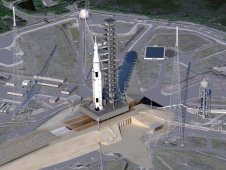 With the Space Shuttle fleet now well into retirement, and American astronauts relying on Russian rockets to get to the International Space Station (ISS), the recent announcement from NASA this week comes as welcomed news. According to the agency, the design teams working on the core launch system for the next-generation Orion spacecraft have reached a significant milestone.
With the Space Shuttle fleet now well into retirement, and American astronauts relying on Russian rockets to get to the International Space Station (ISS), the recent announcement from NASA this week comes as welcomed news. According to the agency, the design teams working on the core launch system for the next-generation Orion spacecraft have reached a significant milestone.
Known as the Space Launch System (SLS), the platform is critical to the success of the upcoming Orion spacecraft program which will get the U.S. back into manned space flight from its home soil. This week NASA reported that the core stage preliminary design review (PDR), held Thursday at NASA’s Marshall Space Flight Center in Huntsville, Alabama to ensure the design meets system requirements within acceptable risk and falls within schedule and budget constraints, revealed important progress.
“Passing a preliminary design review within 12 months of bringing Boeing on contract shows we are on track toward meeting a 2017 launch date,” said Tony Lavoie, manager of the SLS Stages Element at Marshall. “We can now allow those time-critical areas of design to move forward with initial fabrication and proceed toward the final design phase — culminating in a critical design review in 2014 — with confidence.”
On its first launch in 2017, the flight test of the SLS will be in a configuration for a 70-metric ton lift capacity and an unmanned Orion spacecraft beyond the moon. When complete, the final design on the SLS will include a two-stage launch vehicle with a lift capability of 130-metric tons allowing for deep space exploration and other missions beyond the former limits of the Shuttle fleet which was restricted to low-Earth orbit.
“Each individual element of this program has to be at the same level of maturity before we can move the program as a whole to the next step,” SLS Program Manager Todd May said. “The core stage is the rocket’s central propulsion element and will be an optimized blend of new and existing hardware design. We’re building it with longer tanks, longer feed lines and advanced manufacturing processes. We are running ahead of schedule and will leverage that schedule margin to ensure a safe and affordable rocket for our first flight in 2017.”
![Herbal Reference Substances are Key to Everyday Products <!-- AddThis Sharing Buttons above -->
<div class="addthis_toolbox addthis_default_style " addthis:url='http://newstaar.com/herbal-reference-substances-are-key-to-everyday-products/3512112/' >
<a class="addthis_button_facebook_like" fb:like:layout="button_count"></a>
<a class="addthis_button_tweet"></a>
<a class="addthis_button_pinterest_pinit"></a>
<a class="addthis_counter addthis_pill_style"></a>
</div>When it comes to quality control testing and the development of new products, Botanical Reference Materials (BRMs), also known as Herbal References are critically important. To help companies ultimately obtain all-important FDA approval, the Food and Drug Administration provides in its guidance a recommendation that […]<!-- AddThis Sharing Buttons below -->
<div class="addthis_toolbox addthis_default_style addthis_32x32_style" addthis:url='http://newstaar.com/herbal-reference-substances-are-key-to-everyday-products/3512112/' >
<a class="addthis_button_preferred_1"></a>
<a class="addthis_button_preferred_2"></a>
<a class="addthis_button_preferred_3"></a>
<a class="addthis_button_preferred_4"></a>
<a class="addthis_button_compact"></a>
<a class="addthis_counter addthis_bubble_style"></a>
</div>](http://newstaar.com/wp-content/uploads/2021/02/Achillea_millefolium_flowers-100x100.jpg)
![Quality Electrochemical Biosensors are Critical for Medical, Food and Chemical Industry <!-- AddThis Sharing Buttons above -->
<div class="addthis_toolbox addthis_default_style " addthis:url='http://newstaar.com/quality-electrochemical-biosensors-are-critical-for-medical-food-and-chemical-industry/3512086/' >
<a class="addthis_button_facebook_like" fb:like:layout="button_count"></a>
<a class="addthis_button_tweet"></a>
<a class="addthis_button_pinterest_pinit"></a>
<a class="addthis_counter addthis_pill_style"></a>
</div>A number of industries have, at their core, a need to frequent or even continuous analysis of biological media. These include the medical and pharmaceutical fields, biotech firms, and food and chemical companies. To maintain quality standards and develop new products, these industries rely heavily […]<!-- AddThis Sharing Buttons below -->
<div class="addthis_toolbox addthis_default_style addthis_32x32_style" addthis:url='http://newstaar.com/quality-electrochemical-biosensors-are-critical-for-medical-food-and-chemical-industry/3512086/' >
<a class="addthis_button_preferred_1"></a>
<a class="addthis_button_preferred_2"></a>
<a class="addthis_button_preferred_3"></a>
<a class="addthis_button_preferred_4"></a>
<a class="addthis_button_compact"></a>
<a class="addthis_counter addthis_bubble_style"></a>
</div>](http://newstaar.com/wp-content/uploads/2020/10/Electrochemical-Biosensor-100x100.jpg)
![Company Develops Industrial Mixers Well-Suited for both Fragile and Explosive Products <!-- AddThis Sharing Buttons above -->
<div class="addthis_toolbox addthis_default_style " addthis:url='http://newstaar.com/company-develops-industrial-mixers-well-suited-for-both-fragile-and-explosive-products/3512071/' >
<a class="addthis_button_facebook_like" fb:like:layout="button_count"></a>
<a class="addthis_button_tweet"></a>
<a class="addthis_button_pinterest_pinit"></a>
<a class="addthis_counter addthis_pill_style"></a>
</div>Industrial drum mixers are normally applied to blend mixes of varying viscosities such as adhesive slurries or cement. Some of these mixers have the capability of blending mixes of very different particle sizes such as fruit and ice cream, and gravel and cement slurry. The […]<!-- AddThis Sharing Buttons below -->
<div class="addthis_toolbox addthis_default_style addthis_32x32_style" addthis:url='http://newstaar.com/company-develops-industrial-mixers-well-suited-for-both-fragile-and-explosive-products/3512071/' >
<a class="addthis_button_preferred_1"></a>
<a class="addthis_button_preferred_2"></a>
<a class="addthis_button_preferred_3"></a>
<a class="addthis_button_preferred_4"></a>
<a class="addthis_button_compact"></a>
<a class="addthis_counter addthis_bubble_style"></a>
</div>](http://newstaar.com/wp-content/uploads/2020/06/bandeau-sofragir2-100x100.jpg)